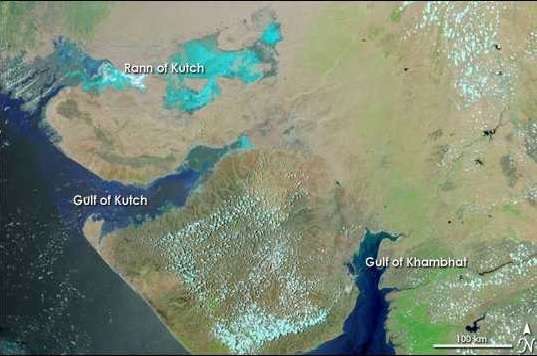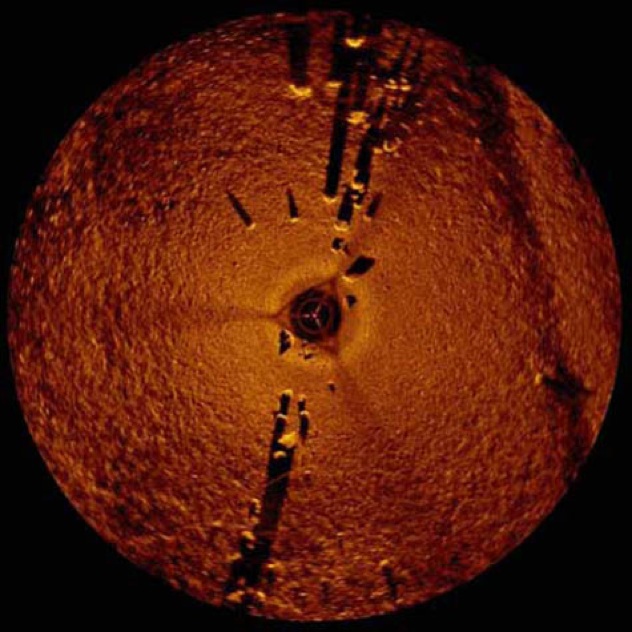Yonaguni Monument
Off the coast of the Yonaguni island, the most southern of the Ryuku Islands in Japan is located one of the world’s most mysterious underwater structures - the Yonaguni Monument. It was discovered by a local diver in the 1980s who was stunned by massive rectangular formations with perfect 90 degree angles, straight walls, steps, columns and what appears to be a human face carved in the rock. Soon, a team of scientists led by Masaaki Kimura visited the underwater structure and concluded that it had to be man-made. The only logical explanation is that the structure was built when the site was above sea level which was around 10,000 years BC or according to the latest findings, about 3,000 to 2,000 years ago when it was sunk by an earthquake. Not all, however, are convinced that the Yonaguni Monument was made by human hands.
Underwater City in the Gulf of Cambay (Gulf of Khambhat Cultural Complex)

The Underwater City in the Gulf of Cambay, also known as the Gulf of Khambhat Cultural Complex is a huge submerged city off the western coast of India, 120 feet (36 meters) below the sea level. It was discovered accidentally in 2001 by Indian oceanographers who found enormous geometrical structures with a side-scan sonar. The site was soon investigated and identified as undoubtedly man-made. Marine archaeologists found construction material, sections of walls, sculpture, pottery and human remains. These were carbon dated and found to be about 9,500 years old. This corresponds with the end of the Ice Age some 9,000 to 10,000 years ago when the melting of the ice caps elevated the sea levels and probably also submerged the ancient city in the Gulf of Cambay. If the Underwater City in the Gulf of Cambay is really as old as it appears to be, it predates the earliest known cities in Mesopotamia for as much as 5,000 years.
Pavlopetri
A UNESCO World Heritage Site and officially the world’s oldest submerged town is located just off coast of southern Peloponnese region of Laconia, Greece, 10 to 13 feet (3 to 4 meters) below the sea level. It covers an area of 322,917 square feet (30,000 square meters) where have been found buildings, streets, courtyards, tombs and graves. Pavlopetri (named after the nearby islet of same name) was built about 5,000 years ago which means that it predates the golden era of ancient Greece for over two millennia. The city is believed to be submerged about 1,000 BC by an earthquake and according to some scholars, possibly inspired the Plato’s story about Atlantis.
Google Earth Circular Anomalies

The circular anomalies that can be seen off the coast of Florida, North Carolina, and Belize have been documented by enthusiasts and archaeologists alike. Even though they are found on a global scale, their true objective hasn’t been discovered so far – many believe they were used as an ancient type of burial mound. They are also very similar to stone structures that have been found in Saudi Arabia that can be seen on this website. It is believed that the underwater structures have been better preserved than those on dry land and may date back to ±8,000 BC. as those in Saudi Arabia have been dated to around 7,000 BC.
Structure in Lake Macdonald, Ontario

Divers discovered proof of Eastern Canada’s ancient past while taking part in a unique submarine project in 2005. They found the very curious stone structure at a depth of 40 feet (12 m) below the surface. It consists of a massive 1,000 lb (453 kg) elongated rock with an almost completely level surface resting on 7 baseball-sized stones, which in turn sits on a huge several thousand pound slab on top of a ledge. It was thought to be a natural formation until geologists and archaeologists looked at the images. The discovery of the man-made “rock cairn”, was deemed to be proven when an underwater archaeologist concluded the existence of three shims was enough proof that the structure was man-made.
Lake Michigan’s Stonehenge

Even though Stonehenge in the UK is one of the most famous historical stone monuments in the world, it is not unique. Similar stone arrangements have been found worldwide. In 2007 while surveying the bottom of Lake Michigan with sonar, a team of underwater archaeologists discovered a series of stones aligned in a circle 40 feet (12 m) below the surface. One of the stones also seemed to feature a carving of a mastodon, an animal that has been extinct for 10, 000 years. If the site is validated, it would not be completely out of place, as other stone circles and petroglyph sites can be found in the vicinity.
Cuba’s Underwater City

A series of submerged structures discovered off the Cuban coast in 2001 captured the imaginations of archaeologists, researchers and Atlantis-hunters worldwide. Found by a company doing surveying work, the sonar images have shown symmetrical and geometric structures that covers an area of 200 ha (almost 2 square km) at depths between 2,000 and 2,460 feet (± 700 m). Skeptics believe the site is too deep to be manmade as it is estimated that it would have taken the structures 50,000 years to sink to their current depth. If conclusive proof can be found that these structures were indeed manmade, it would back up the Maya and local Yucatecos stories of an ancient island inhabited by their ancestors that vanished beneath the sea.
Underwater ‘Crop Circles’ Discovered Off the Coast of Japan


Rippling geometric sand patterns nearly six feet in diameter almost 80 feet below sea level.


Using underwater cameras the team discovered the artist is a small puffer fish only a few inches in length that swims tirelessly through the day and night to create these vast organic sculptures using the gesture of a single fin. Through careful observation the team found the circles serve a variety of crucial ecological functions, the most important of which is to attract mates. Apparently the female fish are attracted to the hills and valleys within the sand and traverse them carefully to discover the male fish where the pair eventually lay eggs at the circle’s center, the grooves later acting as a natural buffer to ocean currents that protect the delicate offspring. Scientists also learned that the more ridges contained within the sculpture resulted in a much greater likelihood of the fish pairing.
http://www.thisiscolossal.com/2012/09/mysterious-underwater-crop-circle-art-discovered-off-the-coast-of-japan/
History Lists · Other · List of 5 Most Mysterious Underwater Structures
http://historylists.org/other/list-of-5-most-mysterious-underwater-structures.html
http://listverse.com/2013/05/20/10-mysterious-underwater-anomalies/